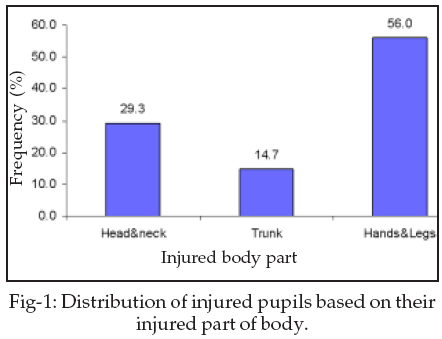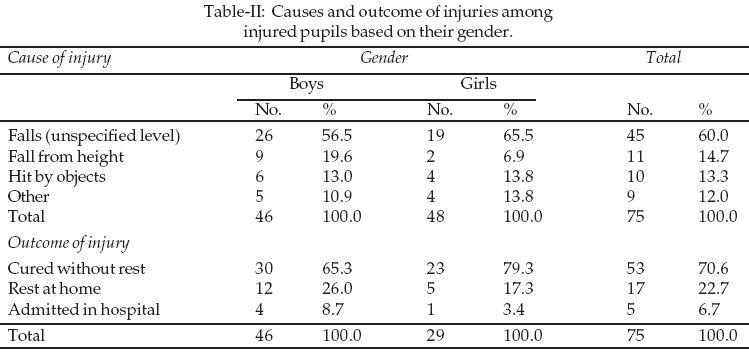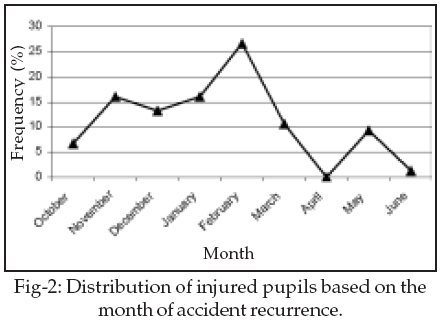|
|
||||
|
Published by : PROFESSIONAL MEDICAL PUBLICATIONS |
||||
|
ISSN 1681-715X |
||||
|
||||
|
- |
||||
|
ORIGINAL ARTICLE |
||||
|
- |
||||
|
Volume 24 |
April - June 2008 (Part-I) |
Number 2 |
||
|
|
||||
|
|
||||
|
|
||||
|
Published by : PROFESSIONAL MEDICAL PUBLICATIONS |
||||
|
ISSN 1681-715X |
||||
|
||||
|
- |
||||
|
ORIGINAL ARTICLE |
||||
|
- |
||||
|
Volume 24 |
April - June 2008 (Part-I) |
Number 2 |
||
|
|
||||
|
|
||||
One-year incidence rate of injuries
among secondary school pupils in
an Iranian community
Abbas Esmaeili1, Reza Vazirineja2, Azam Ebrahiminejad3
ABSTRACT
Objective: To describe the risk and the patterns of injuries taking place inside the secondary schools among pupils in an Iranian community.
Methodology: A follow up study was conducted for measuring incidence of injuries. Total population of 3371 pupils were followed and all injuries were recorded. Information about age, gender, deprivation, time, day and month of injuries, cause and the outcome of injuries were collected using a checklist.
Results: Seventy five cases of injury were reported giving an overall one-year incidence rate of 22.2 per 1000 person-years-at-risk. The maximum incidence was reported among year three pupils in both genders (33 per 1000 boys and 19.8 per 1000 girls). "Falls" was the most common cause of injuries. Legs and hands were the main injured body area (56%). Majority of injuries were "cured without rest" and only five pupils were admitted in hospital.
Conclusion: Comparing to similar results reported by others, the risk of experiencing an injury among secondary school pupils during one academic year is high. Preventing "fall" can be targeted in programs for reducing the level of risk in secondary school pupils.
KEYWORDS:
Injuries, Incidence rate, Deprivation, Relative risk.Pak J Med Sci April - June 2008 (Part-I) Vol. 24 No. 2 236-240
1. Abbas Esmaeili,
Rafsanjan University of Medical Sciences,
Social Medicine Department,
Medical School, Enqelab Sq.,
Rafsanjan, Iran.
2. Reza Vazirinejad PhD,
3. Azam Ebrahiminejad, MD,
Social Medicine Department, Medical School,
Rafsanjan University of Medical Sciences,
Rafsanjan, Iran.
Correspondence
Abbas Esmaeili,
E-mail: esmailiabbas@yahoo.com
* Received for Publication: June 28, 2007
* Revision Received: January 26, 2008
* Revision Accepted: January 28, 2008
INTRODUCTION
Environmental factors as well as factors related to host and agent should be studied when studying accidents and resulting injuries. Although carelessness, thoughtlessness and over confidence are reported as the cause of injuries, environmental factors play an important roles before, during and after a trauma event.
1 Accidents and resulting injuries have been known as one of the most important causes of disabilities and death in both developed and developing countries affecting people at all ages.2,3Injuries are important not only in terms of bringing psychological stresses for victims and their families but also for it’s economic disadvantages due to losing productive days of individuals’ lives.
4 Injuries in the school environment are serious public health problems and it is estimated that 20% of injuries to school-aged children in United States occur on school premises.4-6 Injuries are reported as the most common cause of mortality in children and account for considerable childhood morbidity.7 There are many publications representing their results on accidents in general8,9 as well as road accidents.1,10 A previously conducted study in the area showed that domestic accidents were more frequently reported among elderly and children less than ten years old than others,11 but fewer studies are specifically conducted to investigate the risk of injuries, in particular among secondary schools (SSs) pupils (children between 12 & 16 years) in Asian communities.The present study aims to estimate one-year age and gender incidence rate of injuries patterns and their outcome among pupils studying in secondary schools of an urban area in Southeast, Iran, between October 2005 and September 2006.
METHODOLOGY
The study took place in Shar-babak district, Kerman province, 750km south of Tehran, in Southeast of Iran. A total urban population of pupils studying in the secondary schools of the city were followed for one academic year. In this study, injury denoted the somatic medical consequences of an accident. An accident was defined as ‘a sudden, unexpected series of undesired occurrence in the interplay between individual and environment which led to personal injury
12. Information about all accidents which took place among pupils inside their secondary schools during October 2005 to September 2006 was collected. Accidents taking place outside the schools (on the road, at home or public places) were excluded from the study.Study check list was sent to all Secondary Schools (SSs) distributed throughout the city (26 SSs) and their health officers were educated to complete the checklist once an injury had taken place among pupils. They were paid to collect the data about all injuries to pupils during the year. All major (medical treatment was needed) and minor (medical treatment was not needed) injuries serious enough to be reported by injured pupils were included.
Information about age, gender, time of injuries, day and month of injuries, deprivation, cause of injuries, injured areas of body and the outcome of injuries were collected. In terms of deprivation, since pupils registered in private secondary schools should pay for their study, they are normally classified in a higher social class than those pupils who are studying in free national secondary schools. The latter groups of pupils are considered as having a lower level of cultural, social and economic welfare than pupils studying in the other group of secondary schools.
Causes of injuries refer to the type of accident that are classified into five groups listed as "falls (from unspecified level)", "violence", "falls (from height)", "hit by objects" and "other". Outcome of injuries is considered as "cured without rest", "rest at home" and "admitted in hospital".
Although, there was no death and migration in the population of pupils for the duration of study, person-years-at-risk (PYAR) was used as the denominator for injury incidence. Data were entered into SPSS for analysis. Significant differences between incidence rates of injuries were noted where the 95% confidence interval of the relative risk (RR) excluded unity. Some other parametric tests (z-test, ANOVA) and non-parametric tests (Chi-square, Fisher-Exact) were also used where appropriate.
The Research Ethics Committee at Rafsanjan University gave approval for the data collection and informed consent for recording the data was obtained from both the district headquarters of school education and all secondary schools.
RESULTS
A total population of 3371 pupils studying in 26 PSs (all PSs of the city) were studied. The mean age of victims was 13.2±1.4 years (Min= 12, Max =16yrs). Sex ratio (M/F) was 1.6 and there was no significant difference between the mean age of boys (13.4±0.9 yrs) and girls (12.9±1.9 yrs).
One-year incidence rate of injuries in two genders based on their class is presented in Table-I. The highest incidence rate of injuries among boys belonged to class three (33.1 per 1000 PYAR) and among girls, class two pupils (22.0 per 1000 PYAR). Overall, class three pupils faced higher risk of injuries (26.7 per 1000 PYAR).

Causes and outcomes of injuries among boys and girls are listed in Table-II. As table shows "falls" (56.5%, n=26 among boys and 65.5%, n=19 among girls) was the most common cause of injuries followed by "fall from height" among boys (19.6%, n=9) and "hit by objects" among girls (13.8%, n=4). There was no significant difference between the proportion of boys and girls who experienced injuries due to different causes.

The outcome of injuries among injured boys and girls is also presented in Table-II. Overall, the most common outcome due to injuries at SSs was "cured without rest" reported for 70.6% of cases (n=53). There was no significant difference of injuries’ outcome between boys and girls. Five pupils (6.7%) were admitted in hospital and 17 (22,7%) had rest at home due to injuries. Most common activity which led to injuries was sports in forty five (60%) of cases.

The distribution of injured pupils based on their injured part of body is presented in Fig-1. As the figure shows in 61.4% of accidents legs and hands were injured. The distribution of injured pupils based on the month of incident is presented in Fig-2.

DISCUSSION
Accidents and resulting injuries in particular related disabilities and death are tragic and have a profound impact on the individuals and their families.
9 Epidemiological information about this health problem in a given population of Secondary Schools pupils, which is a part of the aim of this study, is important not only for planning of resources, but also for adequate treatment, prevention and rehabilitation.Based on overall incidence rate of injuries in our study, the risk of experiencing an injury for each pupil studying in Secondary Schools of the city, during an academic year, is about 0.022 (22.2 per 1000 PYAR). This indicates an overall level of risk for each SS pupil to experience at least one injury during his presence in the school for the duration of an academic year. In a study conducted by Sosnowska and Kostka, the overall level of risk for experiencing an injury among 7-15 years old students in an area in Poland was reported as 0.011 which is less than the risk calculated in our study population.
13 In our study, regardless the gender, this risk for class three pupils increases to about 0.026. This valuable information can be used for planning in different areas of prevention and treatment as well as for evaluating the effect of health programs aiming to reduce the occurrence of injuries in the SSs.Greater level of overall incidence rate (IR) of injuries among boys than this level among girls obtained from our data is similar to the results of others.
6,14,15 For instance, Scheidt et al reported a RR indicating a significantly higher level of risk (RR= 1.56, 95% CI= 1.37-1.68) for experiencing injuries among male pupils than this level among female pupils. Spady et al also reported a significant odds ratio showing a higher level of risk of injuries (OR= 1.82, 95%CI = 1.76-1.88) among male pupils than that among female pupils.14 These similar results collected from different nations around the world show that there is a clear higher risk of experiencing injuries for boys in comparison with this risk for girls in SSs regardless cultural and socio-economic differences. This finding might reflect more risk-taking behaviour of male children than female children and should be noticed while planning for preventing this health problem in particular in health education programs. However, one exception was observed in our results. Among class one pupils, interestingly, the level of risk of experiencing injury among female group was greater than this level among male group. More investigations are needed to explain determinants responsible for this diversity.Occurrence of serious injuries in SS pupils is also important in terms of losing a longer duration of living as a healthy person for the rest of their life. Therefore, investing in preventing injuries can have some extra advantages for this particular age group. The role of schools in this regard is also vital as they can teach students the skills needed to promote safety and prevent injuries while at home, at work, at play, in the community and throughout their lives. The results of this study can help in providing recommendations for preventing injuries among SS pupils in the area. However, as a reference, the level of the risk of injuries in an urban Iranian community of SS pupils estimated in our study could be used for comparing with the level of this risk in SS pupils of the other parts of the world. It is well-known that most of risk factors for childhood injuries are predictable and therefore preventable.
15 Investigations like the present study should be conducted to identify these risk factors. The results of our study showed that "falls from unspecified level" was the most common cause of accidents in the secondary schools. It can be realised from our results that in order to decrease the risk of injuries at secondary schools, health programs should be mainly focussed on reducing "falls" (either falls from unspecified levels or falls from height). Falls are reported as an important cause of accidents and related injuries in all European, African, Australian and American populations,2,16-18 and are particularly important among older people.19 Although, risk factors for falls among elderly people have been extensively reviewed.19 more investigations are needed for exploring factors related to fall among young people.Our results showed that a majority of injuries (26.7%) took place in February. Since this month is the middle of the winter and also the city is located among mountains, therefore greater number of accidents and related injuries can be due to the slippery surface of school yards at this time of year.
The severity of injuries reported in this study is consistent with what is reported by Miller and Spicer who conducted a study in USA.
15 They reported that very big majority of injuries in the schools is mild and approximately one in 400 injury-related fatalities among children aged 5-19 years occurred at school. Our data showed that only 5.6% of cases in our study were admitted in hospital and nobody died due to injuries.Schools as the central socialisation institution, plays a key role in the process of continued improvement.
20 The present study to the best of our knowledge is the first study conducted to calculate the level of risk of injuries among secondary schools pupils in the area.The findings of this study provide some new insights into the epidemiology of school-related injuries and can be useful information for the planning of strategies to reduce the risk of injuries in Iranian schools. The result has highlighted the need for a nationwide surveillance system for monitoring and preventing injuries among secondary school pupils. Hence, health programs, including health education, for preventing secondary school injuries to ensure safer schools for students must be developed.
REFERENCES
1. Jha N, Srinivasa DK, Roy G, Jagdish S. Epidemiological study of road traffic accident cases: A study from South India. Indian J Community Med 2004;29(1):20-4.
2. Majori S, Bonizzato G, Signorelli D, Lacquaniti S, Andreeta L, Baldo V. Epidemiology and prevention of domestic injuries among children in the Verona area (north-east Italy). Ann Ig 2002;14(6):495-502.
3. Watters DAK, Dyke T. Trauma in Papua New Guinea: what do we know and where do we go? PNG Med J 1996;39:121-5.
4. Knight S, Junkins EP, Lightfoot AC, Cazier CF, Olson LM. Injuries sustained by Students in Shop Class. Pediatrics 2000;106(1):10-3.
5. Latif AHA, Williams WR, Sibert J. Primary School accident reporting in one education authority. Arch Dis Child 2002;86:91-4.
6. Scheidt P, Harel Y, Trumble A, Jones D, Overpeck M, Bijur P. The epidemiology of nonfatal injuries among US children and youth. Am J Public Health 1995;85:932-8.
7. Kendrick D. Role of the primary health care team in preventing accidents to children. Br J Gen Pract 1994;44:372-5.
8. Nieminen S, Lehtonen OP, Linna M, Population density and occurrence of accidents in Filand, Prehospital Disaster Med 2002;17(4):206-8.
9. Singh R, Sharma SC, Mittal R, Sharma A. Traumatic spinal cord injuries in Haryana: An epidemiological study. Indian J Community Medicine 2003;28(4):184-6.
10. Johnston I. Action to reduce road casualties. World Health Forum 1992;13:154-62.
11. Vazirinejad R, Esmaeili A, Dashti K, Lilley J. A community-based survey of domestic accidents among people living in the rural area of Rafsanjan-Iran (April 2003 – March 2004). In 1st International Conference of Safety and Security Engineering (Safe 2005), 12-15 June 2005, Italy (Rome), WIT Press, 2005;855-62.
12. Svanstrom L. Community intervention in accident and injury prevention in Indonesia. Stockholm: Department of Social Medicine, Karolinska Institute; 1990.
13. Sosnowska S, Kostka T. Epidemiology of school accidents during a six school-year period in one region in Poland. Eur J Epidemiol 2003;18(10):977-82.
14. Spady DW, Saunders DL, Schopflocher DP, Svenson LW. Patterns of injury in children: a population-based approach. Pediatrics 2004;113(3):522-9.
15. Miller TR, Spicer RS. How safe are our schools? Am J Public Health 1998;88:413-8.
16. Vyrostek SB, Annest JL, Ryan GW. Surveillance for fatal and non-fatal injuries- United States. MMWR Surveill Summ 2004;53(7):1-57.
17. Baldo V, Marcolongo A, Floreani A, Majori S, Cristofolettil M, Dalzotto A, et al. Epidemiological aspect of Traumatic brain injury in Northeast Italy. Eur J Epidemiol 2003;18(11):1059-63.
18. Nordberg E. Injuries as a public health problem in sub-Saharan Africa. Epidemiology and prospect for control. East Afr Med J 2000;77(12 Suppl): S1-43.
19. Lilley JM, Arie T, Chilvers CED. Special review, accidents involving older people: A review of the literature. Age Ageing 1995;24:346-65.
20. Hundeloh H, Hess B. Promoting safety- a component in health promotion in primary and secondary schools. Inj Control Saf Promot 2003;10(3):165-71.
HOME | SEARCH | CURRENT ISSUE | PAST ISSUES
Professional
Medical Publications
Room No. 522, 5th Floor, Panorama Centre
Building No. 2, P.O. Box 8766, Saddar, Karachi - Pakistan.
Phones : 5688791, 5689285 Fax : 5689860
pjms@pjms.com.pk